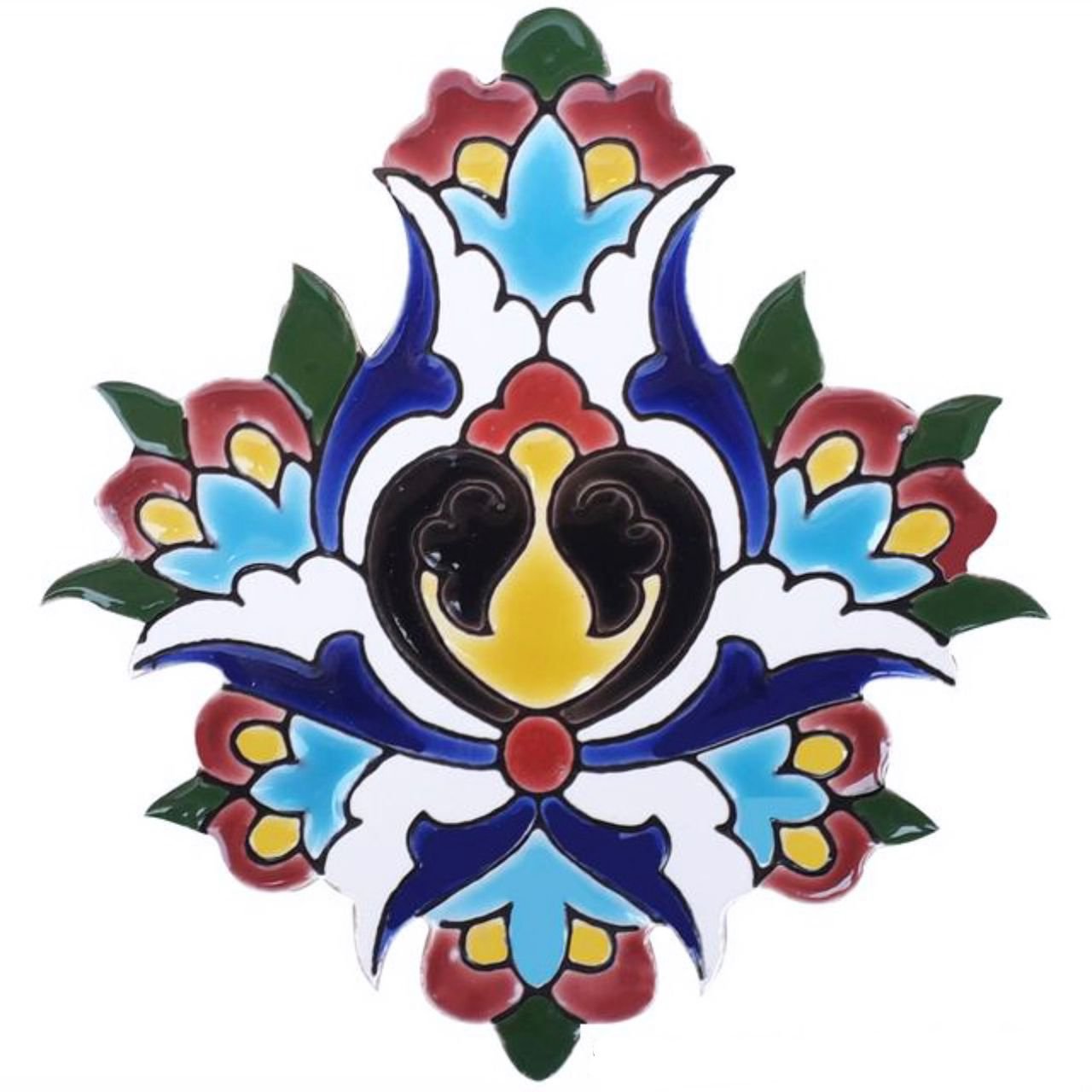
Blog
Shah Abbasi Flower Motif: Evolution, Symbolism, and Influence in Persian Art and Design

The rich tapestry of Persian art and culture is renowned for its intricate designs, stunning use of colour and timeless beauty. Among the many artistic symbols that have shaped Persian heritage, the Shah Abbasi flower motif holds a unique place. Named after Shah Abbas I, the ruler of the Safavid dynasty in Persia from 1588 to 1629, this motif represents an era of artistic flourishing. The Shah Abbasi flower motif, with its elegant lines and sophisticated design, embodies the essence of Persian aesthetics, leaving a lasting legacy that has transcended time and geographical boundaries.
Historical Origins and Context
Shah Abbas I is regarded as one of Persia’s most influential rulers, known for his transformative contributions to architecture, trade, and the arts. Under his reign, Persian art underwent a remarkable renaissance, blending traditional Islamic patterns with new influences from China, Central Asia, and Europe. The Shah Abbasi flower motif emerged as one of the most celebrated patterns of this time, gracing textiles, carpets, ceramics, architecture, and even jewellery.
The motif is characterized by its stylized, symmetrical floral designs, typically featuring a central palmette surrounded by smaller floral and leaf patterns. This type of ornamentation is an embodiment of the Safavid dynasty’s artistic achievements, symbolizing balance, order, and beauty. Though its origins are rooted in Islamic art, the Shah Abbasi motif’s development reflects the exchange of ideas and cultural influences from the East and West, particularly through the Silk Road, which facilitated Persia’s interaction with other cultures during Shah Abbas’s reign.
Characteristics of the Shah Abbasi Flower Motif
The Shah Abbasi flower motif is known for its highly stylized representation of flowers often depicted in a symmetrical arrangement. While natural in appearance, the flowers are abstracted and simplified into geometric forms. The typical elements include a central floral shape surrounded by decorative scrolls, curved patterns, and vine-like designs. The motif is often placed within a framework of repeating geometric patterns, creating a harmonious design that combines organic forms with mathematical precision.
One of the most striking features of this motif is its balance and symmetry, which reflect the Persian philosophy of art as a reflection of the cosmic order. The use of floral designs in Persian art also has deeper symbolic meanings, representing life, growth, and paradise. Flowers such as lotuses, tulips, and carnations are commonly used in the Shah Abbasi motif, symbolizing beauty, purity, and divine harmony. These designs are not just decorative; they carry spiritual and cultural significance, deeply rooted in Persian ideals of the connection between nature and the divine.
Application in Persian Carpets
Perhaps the most iconic application of the Shah Abbasi flower motif is in Persian carpets. During Shah Abbas I’s rule, Persian carpet weaving reached unprecedented levels of sophistication, with Isfahan becoming the heart of this artistic endeavour. Carpets featuring the Shah Abbasi motif are among the most celebrated in the world, admired for their intricate patterns, vibrant colours, and exceptional craftsmanship.
The Shah Abbasi motif in carpets typically features large, bold palmettes, often arranged in a central medallion surrounded by floral scrolls and arabesques. The motif can be found in both the field of the carpet and the borders, creating a unified and cohesive design. These carpets are not only functional objects but also works of art, valued for their aesthetic beauty and the meticulous skill required to create them.
The colours used in Shah Abbasi carpets are also significant. Rich reds, deep blues, and golds dominate the colour palette, often accented with green and ivory. These colours, combined with the floral designs, create a sense of luxury and elegance that has made Persian carpets highly sought after across the globe. The Shah Abbasi motif, with its perfect balance of form and colour, exemplifies the refinement and elegance of Persian carpet weaving.
Influence on Jewellery Design
The Shah Abbasi flower motif’s influence extends beyond textiles and carpets, having a profound impact on Persian jewellery design. Persian jewellery has long been known for its intricate craftsmanship and symbolic richness, and the Shah Abbasi motif, with its delicate and harmonious floral patterns, became a central design element in many pieces of jewellery during and after the Safavid period.
The stylized floral motifs were often transformed into elegant, wearable art, such as necklaces, pendants, rings, and earrings. These designs emphasized symmetry and balance, characteristics that were highly valued in Persian aesthetics. Jewellers would often arrange Shah Abbasi flowers in circular or geometric patterns, using precious stones and metals to create visually striking pieces that embodied the grace and sophistication of Persian art.
Gold and silver were commonly used as the base materials and gemstones such as rubies, emeralds, and sapphires were intricately set to mimic the colourful vibrancy of the original floral designs. The rich hues of these stones echoed the deep reds, blues, and greens seen in Persian carpets and textiles, further uniting the Shah Abbasi motif across different art forms.
Jewellery pieces featuring the Shah Abbasi flower motif were not only valued for their beauty but also for their symbolic significance. In Persian culture, flowers are often associated with concepts of life, renewal, and spirituality. Wearing jewellery adorned with floral motifs was seen as a way to connect with these deeper meanings, offering both aesthetic pleasure and spiritual connection. This tradition continues today, as modern Persian jewellery designers incorporate the Shah Abbasi motif into contemporary designs, creating timeless pieces that bridge the past and present.
Influence on Other Art Forms
Beyond carpets, textiles, and jewellery, the Shah Abbasi flower motif has left its mark on a variety of Persian art forms, including ceramics and architecture. In ceramics, the motif is often used to decorate plates, bowls, and tiles, with the floral patterns painted in intricate detail. Persian ceramics from this period are known for their delicate beauty, with the Shah Abbasi motif lending a sense of grace and refinement to everyday objects.
Even in Persian architecture, the Shah Abbasi motif plays a significant role. The floral patterns can be found in the tile work that adorns mosques, palaces, and public buildings. One of the most famous examples is the Sheikh Lotfollah Mosque in Isfahan, where the walls and dome are decorated with floral and geometric patterns that reflect the Shah Abbasi style. The elegance and harmony of these designs create a sense of serenity and beauty, enhancing the spiritual atmosphere of the space.
The Enduring Legacy of the Shah Abbasi Motif
The timeless elegance of the Shah Abbasi flower motif continues to influence contemporary art and design. Its geometric beauty and harmonious balance have inspired modern interpretations in fashion, interior design, and decorative arts. Persian carpets and jewellery featuring this motif are still produced today, with master artisans preserving the traditional techniques passed down through generations. The appeal of the Shah Abbasi motif lies in its ability to transcend time and culture, embodying universal principles of beauty, order, and craftsmanship.
In addition to its aesthetic appeal, the Shah Abbasi motif serves as a testament to the rich cultural heritage of Persia. It reflects the artistic achievements of the Safavid dynasty, a period of great cultural and intellectual flourishing. The motif is not only a visual delight but also a symbol of Persia’s enduring contributions to the world of art and design.
The Shah Abbasi flower motif represents the pinnacle of Persian artistic achievement, combining elegance, sophistication, and deep cultural significance. Rooted in the rich heritage of the Safavid dynasty, the motif has become a symbol of Persia’s enduring artistic legacy. Whether in the intricate designs of Persian carpets, the delicate patterns on ceramics, the breathtaking tile work of mosques, or the dazzling brilliance of jewellery, the Shah Abbasi motif continues to captivate the imagination and inspire admiration. Its timeless beauty is a testament to the creativity and craftsmanship of Persian artisans, and its legacy lives on as a cherished part of Persian heritage.
